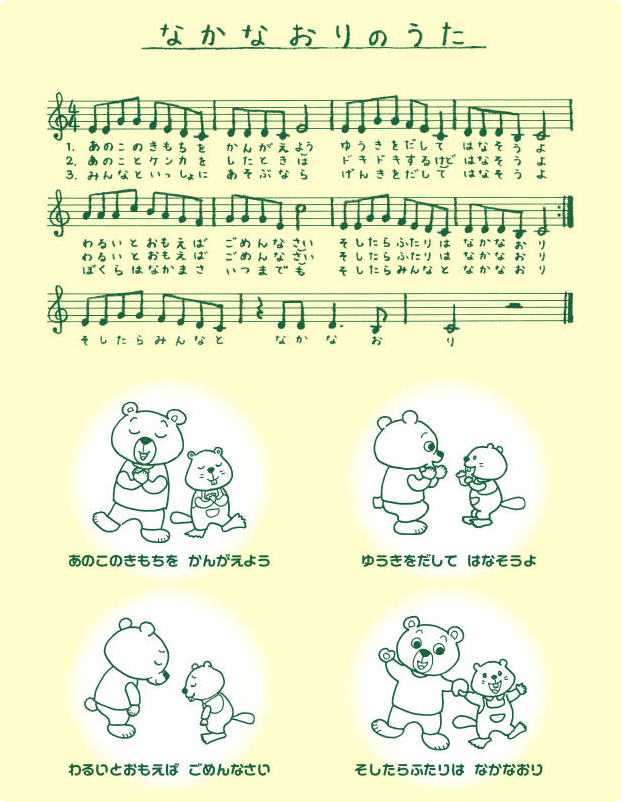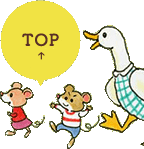Using Picture Books
Parents:
“Nakanaori”, the first book in the KIZUNA Picture Book series, explores the skill of building lasting bonds with others, and how to create harmony in one’s life and in society. It also teaches how to be successful in life as a member of a community. In order for these skills to be truly learned, it should be read to very young children repeatedly.- Read the book to the child for the enjoyment of the story.
- Sing the “Nakanaori” song that is in the middle of the book with the child. By repeatedly singing the song, children will quickly come to memorize it.
- Next, try and teach the meaning of the story and the song to the child. Especially, talk as a parent to a child about the scenes where the bear starts to think about the beaver’s feelings.
- When your child starts to fight, tell them to sing the “Nakanaori” song, and that they should try and get the other child to also sing along. In this way, as the two children start singing and dancing to the song, they will see how they can become friends again.
There are three key concepts in public relations for successful relationship management:
- Ethics
- Two-way communication (talking with each other)
- Self-correction (recognizing when you are wrong, and having the ability and will to take correcting action)
You will even find these three key concepts in the ‘Nakanaori’ song.

Let's think about the feeling of others ♪ ♪
(Ethics)
♪ Let's find the courage to talk♪
(Two-way communication)
I feel sorry ♪ I'm sorry
(Self-correction)
Then we are friends again ♪
Let's begin to read this picture book with our children and start to help them to learn to think about the feelings of others and the method and joy of reconciliation.
Teachers and others taking care of children:
“Nakanaori”, the first book in the KIZUNA Picture Book series
"Think about other people’s feelings, talk to them about it with courage, and apologize if you think you did something bad." From the simple message of this picture book, children can learn to be mindful of the feelings of those around them. Through the main character of the Bear, children can come to cultivate a heart that is considerate of others. And, as children learn the song, they will be able to naturally apply its lessons in their daily life. It is important to develop in very young children this awareness of other’s feelings and the skill of reconciliation. The book’s themes come from a desire to teach the fundamental skills of public relations, which is really about creating bonds with various people so that goals can be achieved through cooperation. In public relations, this is known as relationship management, which one can learn from reading this picture book.There are three key concepts in public relations for successful relationship management:
- Ethics
- Two-way communication (talking with each other)
- Self-correction (recognizing when you are wrong, and having the ability and will to take correcting action)

Let's think about the feeling of others ♪ ♪
(Ethics)
♪ Let's find the courage to talk♪
(Two-way communication)
I feel sorry ♪ I'm sorry
(Self-correction)
Then we are friends again ♪
How to use this book in an actual class:
(Beginning)
Ask children:- “So, what kind of things do you fight over”? Listen to their concrete examples.
- Then take out the book and tell them, “Let’s see if this story can show us how to stop fighting and become friends.”


